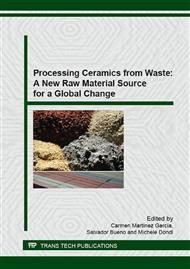[1]
M. M. Nogueira-López, Análisis del hormigón reforzado con fibra de lino, Master en arquitectura y ciudad, ETSAG.
Google Scholar
[2]
P. C. Mármol-Salazar, Hormigones con fibras de acero. Características mecánicas, Master en ingeniería de estructuras, cimentaciones y materiales, Universidad Politécnica de Madrid, (2010).
Google Scholar
[3]
G. Ramakrishna, T. Sundararajan, Impact strength of a few natural fibre reinforced cement mortar slabs: a comparative study, Cement Concrete Comp. 27 (2005) 547-553.
DOI: 10.1016/j.cemconcomp.2004.09.006
Google Scholar
[4]
Y. Li, Y.W. Mai, L. Ye, Sisal fibre and its composites: a review of recent developments, Compos. Sci. Technol. 60 (2000) 2037-(2055).
DOI: 10.1016/s0266-3538(00)00101-9
Google Scholar
[5]
F. E. Morrissey, R. S. P. Coutts, P. U. A. Grossman, Bond between cellulose fibres and cement, Int. J. Cem. Compos. Lightweight Concr. 7 (1985) 73-80.
DOI: 10.1016/0262-5075(85)90062-4
Google Scholar
[6]
D. G. Swift, R. B. L. Smith, The flexural strength of cement-based composites using low modulus (sisal) fibres, Composites 10 (1979) 145-148.
DOI: 10.1016/0010-4361(79)90288-x
Google Scholar
[7]
T. J. Bessel, S. M. Mutuli, The interracial bond strength of sisal cement composites using a tensile test, J. Mater. Sci. Lett. l (1982) 244-246.
DOI: 10.1007/bf00727846
Google Scholar
[8]
H. Baluch, Y. N. Ziraba, A. K. Azad, Fracture characteristics of sisal fibre reinforced concrete, Int. J. Cem. Compos. Lightweight Concr. 9 (1987) 157-168.
DOI: 10.1016/0262-5075(87)90049-2
Google Scholar
[9]
D. G. Swift, R. B. L. Smith, Sisal cement composites as low-cost construction materials, Appropriate Tech. 6 (1979) 6-8.
Google Scholar
[10]
H. E. Gram, Durability of natural fibres in concrete, Swedish Cement and Concrete Research Inst., Stockholm, Sweden, (1983).
Google Scholar
[11]
R. S. P. Coutts, P. G. Warden, Sisal pulp reinforced cement mortar, Cement Concrete Comp. 14 (1992) 17-21.
DOI: 10.1016/0958-9465(92)90035-t
Google Scholar
[12]
F. A. Silva, B. Mobasher, C. Soranakom, R. D. T. Filho, Effect of fiber shape and morphology on interfacial bond and cracking behaviors of sisal fiber cement based composites, Cement Concrete Comp. 33 (2011) 814-823.
DOI: 10.1016/j.cemconcomp.2011.05.003
Google Scholar
[13]
F. A. Silva, R. D. T. Filho, J. A. M. Filho, E. M. R. Fairbairn, Physical and mechanical properties of durable sisal fiber–cement composites, Constr. Build. Mater. 24 (2010) 777-785.
DOI: 10.1016/j.conbuildmat.2009.10.030
Google Scholar
[14]
L. C. Roma Jr., L. S. Martello, H. Savastano Jr., Evaluation of mechanical, physical and thermal performance of cement-based tiles reinforced with vegetable fibers, Constr. Build. Mater. 22 (2008) 668-674.
DOI: 10.1016/j.conbuildmat.2006.10.001
Google Scholar
[15]
R.M. de Gutiérrez, L.N. Díaz, S. Delvasto, Effect of pozzolans on the performance of fiber-reinforced mortars, Cement Concrete Comp. 27 (2005) 593-598.
DOI: 10.1016/j.cemconcomp.2004.09.010
Google Scholar
[16]
R. D. T. Filho, K. Ghavami, M. A. Sanjuán, G. L. England, Free, restrained and drying shrinkage of cement mortar composites reinforced with vegetable fibres, Cement Concrete Comp. 27 (2005) 537-546.
DOI: 10.1016/j.cemconcomp.2004.09.005
Google Scholar
[17]
M. Barreda, C. Iaiani, J. D. Sota, Hormigón reforzado con fibras de polipropileno: tramo experimental de un pavimento de hormigón, Jornadas SAM 2000-IV Coloquio Latinoamericano de Fractura y Fatiga, 1145-1150.
DOI: 10.4995/thesis/10251/10360
Google Scholar
[18]
J. A. Sullcahuamán, C. A. Fuentes Rojas, M. Mateo Ramos, A. V. Pastor Revoredo, O. N. Castro Mandujano, J. S. Zavaleta Cortijo, Materiales compuestos de cemento, papel reciclado, quitosano y refuerzo de fibras de sisal químicamente modificadas, 8º Congreso Iberoamericano de Ingeniería Mecánica, Perú, (2007).
DOI: 10.5944/bicim2022.090
Google Scholar
[19]
F. Muñoz Cebrián, Comportamiento mecánico del hormigón reforzado con fibra de polipropileno multifilamento: Influencia del porcentaje de fibra adicionado, Taller proyecto final de grado en materiales avanzados, Universidad Politécnica de Valencia, (2010).
DOI: 10.18002/10612/1759
Google Scholar
[20]
V. Águila Higuero, Características físicas y mecánicas de hormigones reforzados con fibras de: vidrio, carbono y aramida, Master universitario en ingeniería de las estructuras, cimentaciones y materiales, Universidad Politécnica de Madrid, (2010).
DOI: 10.14483/23448393.18852
Google Scholar
[21]
S. Popovics, Concrete Materials: Properties, Specifications, and Testing, second ed., Noyes Publications, USA, (1992).
Google Scholar
[22]
A. C. H. Barreto, D. S. Rosa, P. B. A. Fechine, S. E. Mazzetto, Properties of sisal fibers treated by alkali solution and their application into cardanol-based biocomposites, Compos. Part A-Appl. S. 42 (2011) 492-500.
DOI: 10.1016/j.compositesa.2011.01.008
Google Scholar
[23]
UNE-EN 12390-1: 2013, Ensayos de hormigón endurecido. Parte 1: Forma, dimensiones y otras características de las probetas y moldes.
Google Scholar
[24]
UNE-EN 1008: 2007, Agua de amasado para hormigón. Especificaciones para la toma de muestras, los ensayos de evaluación y aptitud al uso incluyendo las aguas de lavado de las instalaciones de reciclado de la industria del hormigón, así como el agua de amasado para hormigón.
DOI: 10.3989/mc.1972.v22.i145.1440
Google Scholar
[25]
UNE 83951: 2008, Durabilidad del hormigón. Aguas de amasado y aguas agresivas. Toma de muestras.
Google Scholar
[26]
UNE-EN 12390-2: 2009, Ensayos de hormigón endurecido. Parte 2: Fabricación y curado de probetas para ensayos de resistencia.
Google Scholar
[27]
UNE-EN 12350-2: 2009, Ensayos de hormigón fresco. Parte 2: Ensayo de asentamiento.
Google Scholar
[28]
UNE-EN 12390-7: 2009, Ensayos de hormigón endurecido. Parte 7: Densidad del hormigón endurecido.
DOI: 10.3989/mc.1969.v19.i133.1602
Google Scholar
[29]
UNE-EN 480-5: 2006, Aditivos para hormigones, morteros y pastas. Métodos de ensayo. Parte 5: Determinación de la absorción capilar.
DOI: 10.3989/ic.1982.v34.i340.2107
Google Scholar
[30]
Instrucción de hormigón estructural (EHE-08). Ministerio de Fomento. Gobierno de España.
Google Scholar
[31]
UNE-EN 12390-3: 2009, Ensayos de hormigón endurecido. Parte 3: Determinación de la resistencia a compresión de probetas.
Google Scholar
[32]
Portland cement association. PCA R&D Serial No. 21.
Google Scholar


